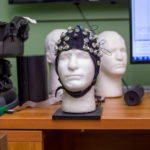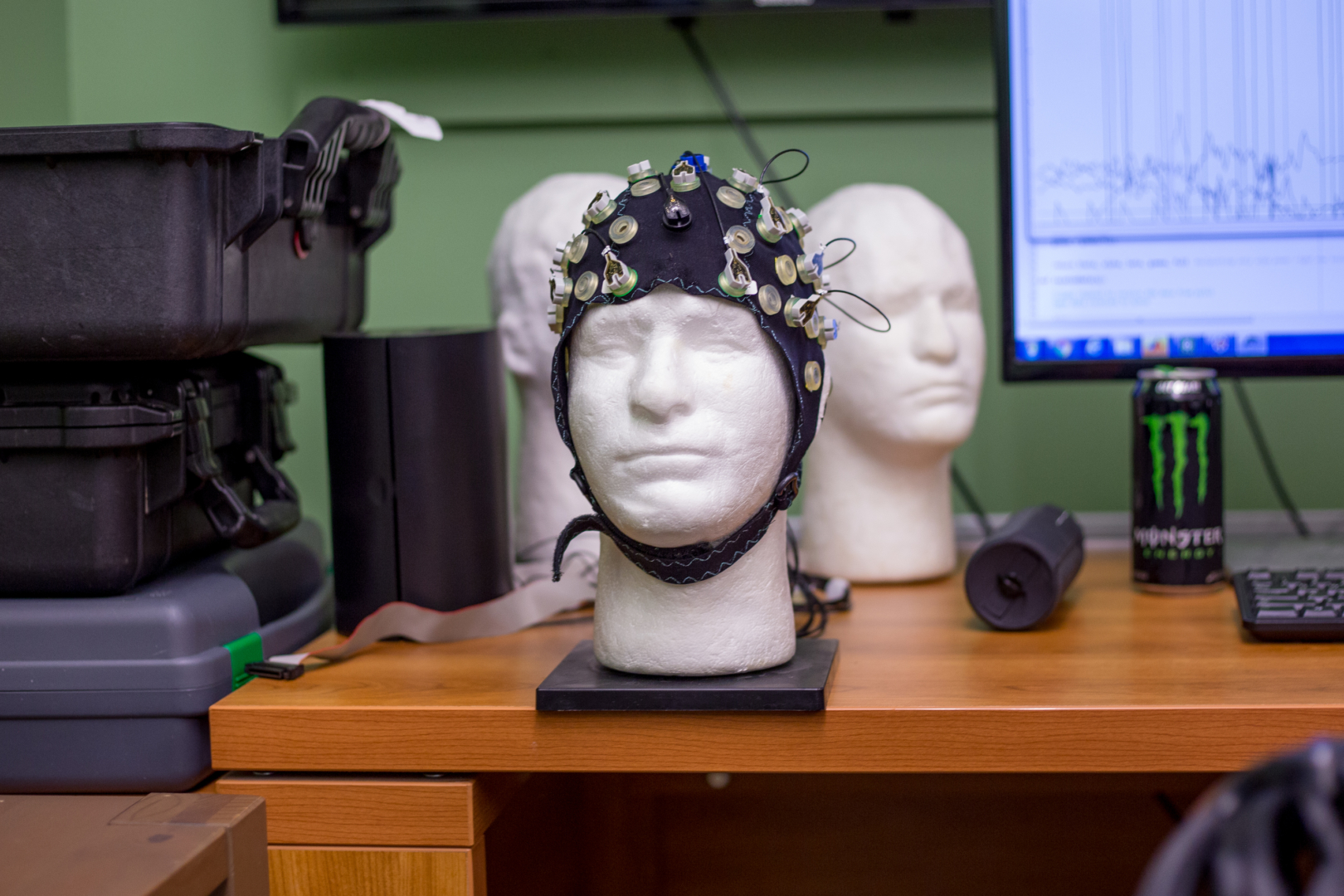

One of the non-invasive caps that Eric Todd had on his desk. The cap lets users control lights and sounds by measuring electrical activity in the brain. | Trevor Nolley/The Cougar
On the fourth floor of Engineering 2, a user can put on a cap and control 16 warbling tones and shifting, illuminating architecture with their brain. A program converts electrical signals in the brain into a technicolor show throughout the laboratory.
Electrical engineering post-baccalaureate Eric Todd, who seeks to find the intersection of art and science while researching in the Non-Invasive Brain Machine Interface Laboratory.
The laboratory is headed by neuroscience professor Jose Luis Contreras-Vidal.
Todd’s current major project is a kinetic sculpture installation, the aforementioned alien-brain-technicolor show, based on principles of both neuroscience and art.
“The idea is capturing the essence of a person, what makes up who we are,” Todd said. “Is it these signals? We see people have parts of their brain damaged and become different people. This is about our identity and who we are.”
The art installation uses acrylic tiles embedded in the ceiling alongside computers —three of the most powerful computers in the lab, Todd said — to immerse the viewer in the lights and sounds produced by measuring their EEG.
EEG, which is short for electroencephalography, is a non-invasive way to read the electrical activity in the brain from the outside of the scalp.
“The installation takes EEG as its input, and we do signal processing on that for our best assumption on what’s happening in someone’s brain based on current science,” Todd said. “I look at different regions in the brain to create a control for different aspects of the installation.”
There are three parts to the installation: the panels on the ceiling are motorized, driven by the brain’s motor cortex information, 640 LED lights within the panels produce an animation that shifts in color in response to the occipital lobe, the brain’s visual processing center, and the frontal cortex, where conscious thought occurs, and four oscillators connected to electrodes reading signals all over the brain.
“I am a visual artist, but I’m also an engineering student,” Todd said. “This lab mostly does brain signal processing, but another part of the focus of the lab is the study of creativity.”
The idea of processing EEG signals is useful for Todd’s work but also for research into medical advancements.
“One facet of the lab is a biomedical facet, so the lab does work in robotics, especially prosthetics you can control with the mind,” Todd said
The electrical engineering post-bacc brought up the work of one of his colleagues in the lab, Jesus G. Cruz-Garza, a Ph.D. student studying the nature of creativity who helped work on the signal processing aspect of the art installation, Todd said.
“We have this experiment with three artists who worked on an ‘Exquisite Corpse,’” Todd said.
Exquisite Corpse is a modernist art game where one artist would draw an entire piece of art, cover up the piece except for a tiny portion, and then have someone else make a new drawing based off the old one, and they would do the same, passing the art onto new artists until they had a completed collaboration.
“It’s sort of a blind improv collaboration,” Todd said. “But while the artists did these we recorded EEG. We’ve done these studies with artists, writers, chefs, just a variety of different people.”
Todd, who already possesses a degree in theatre and creative writing, returned to UH to study electrical engineering as he’d made interactive art using technology, with the help of electrical and software engineers.
“In my past work, I think about space as a primary medium for art making. Art doesn’t exist outside of its environment,” Todd said. “If I think about a painting, it will have a different experience in different spaces for different viewers.”
For Todd, the merger of science and art made perfect sense.
“Engineering is very similar to art and creative work. Both have design choices and problem solving. In the past, when I collaborated with engineers, it was a very natural thing since we had such similar processes,” Todd said.
One future development Todd hopes for is reading archived EEG data to get a snapshot of their mind from when it was recorded.
“I want to use it as a playback device, so you can walk into a moment in someone’s life,” Todd said.
An official opening for the installation may be in the works. Todd said.
“We’re doing a soft open, it’s by appointment, but I’m willing for anyone to come in and see it in its current state,” Todd said. “I want to get through the summer and see where we are about the possibility of expansion.”
Appointments can be made through Todd’s email, eamtodd@gmail.com
features@thedailycougar.com
—
“Art installation lets users control lights, sound with their mind” was originally posted on The Daily Cougar
